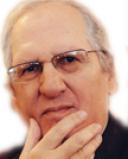Synchronicity
Redefining Reality (Part Two) : Psychotherapy, Synchronicity, and the Rainmaker
Does our subjective state of mind influence objective reality?
Posted January 8, 2010
 In my previous post (Part One), I suggested that we live in two worlds: the inner world and the outer world. That we participate in two different but equally legitimate realities: subjective and objective reality. And that these integrally related realities constantly interface and influence each other. But just how does that happen? What is the relationship between inner, subjective reality and outer, objective reality? Can what happens in the inner world of subjectivity affect, for better or worse, concrete events in the outer world? These are profound and crucial questions for the practice of psychotherapy.
In my previous post (Part One), I suggested that we live in two worlds: the inner world and the outer world. That we participate in two different but equally legitimate realities: subjective and objective reality. And that these integrally related realities constantly interface and influence each other. But just how does that happen? What is the relationship between inner, subjective reality and outer, objective reality? Can what happens in the inner world of subjectivity affect, for better or worse, concrete events in the outer world? These are profound and crucial questions for the practice of psychotherapy.
But let's begin by turning this latter question around: Can what happens in the outer world, what we call consensual objective reality, affect our inner reality, our subjectivity? The answer from the perspective of psychology is certainly a resounding YES. We have all experienced the power of external events--be they catastrophes or crises such as a tsunami or terrorist attack, or receiving an unexpected phone call or e-mail message--to significantly affect how we subjectively feel, one way or another. So clearly, some intrinsic interrelationship exists between outer and inner reality, some link or bridge that connects the two and allows one to influence the other. It can be argued that subjectivity, e.g., cognitive distortions or unconscious complexes, act as intervening internal variables through which outer reality is filtered, interpreted and experienced. But what of the inverse? Does our subjective state of mind, our interior psychological landscape, shape, inform or influence exteriority or objective, outer reality? And, if so, to what extent? And how?
Depth psychology concerns itself with these basic questions. After practicing psychotherapy for more than three decades, it is difficult for me to deny the subtle tie between a patient's inner and outer worlds, and how they tend to inform and reflect each other, oftimes problematically. In this sense, psychotherapy, for me, is about helping the patient to discern the differences between subjectivity and objectivity, between inner and outer reality, to respect and honor both, and to do what he or she can to change either or both when possible or to accept either or both when change is impossible. (See my prior post on Change or Acceptance.) For example, we may be able to change how we subjectively think, perceive or feel about something, someone or ourselves without ever changing outer reality. There may be certain aspects of our subjective experience or inner reality--existential anxiety or loneliness, for example--that cannot be changed and must be accepted. Or, we might make major changes in our external world, yet find that despite altering objective reality--e.g., moving to a different city, finding a new romantic partner, having plastic surgery--our subjective experience remains the same.
Behavior therapy, for instance, focuses mainly on changing or modifying what happens in the outer world of objective, observable reality. In contrast, cognitive therapy, psychopharmacology, and depth psychology--three very different treatment approaches--share a greater kinship than we might concede: each, in their own distinctive way, attempts to alter the patient's subjective reality, recognizing that such interior shifts of mood, perception, and attitude can manifest themselves in positive behavioral changes in the outer world. And that in turn, those beneficial changes in objective reality can themselves serve to reinforce and therapeutically transform the patient's subjective reality and sense of self, creating a sort of "positive snowball" to replace the prior "negative snowball" syndrome.
There are several versions of a parable about a renowned rainmaker. C.G. Jung was so fond of this allegory, he apparently told it whenever possible, feeling strongly that it spoke to the very essence of his own philosophy of psychotherapy. The story goes something like this:
A tiny village in China was suffering from the most severe drought anyone there could ever recall. There had not been a drop of rain for many months in an environment that depended on regular rainfall for its survival. The crops were dying. There was little food left. The water supply was running dangerously low. Dust flew everywhere, making it difficult for residents to breath. Death hung in the air. All manner of traditional rituals, ceremonies and petitionary prayers were attempted in hopes of driving away any evil demons or negative spirits and ending the devastating drought. But, despite their best efforts, no rain came. Desperate, the village elder decided to send for professional assistance from a far away province: a renowned rainmaker. Upon arriving, the old, wizened rainmaker requested something very strange. He directed the villagers to construct a small straw hut just outside the village itself, to bring him enough food and water to last for five days, and to then leave him there alone, solitary, absolutely undisturbed. Not sure what to think, the frightened villagers did exactly as he said, and anxiously waited. Nothing happened. Three days passed uneventfully. But on the fourth day, dark clouds suddenly appeared. And it began to rain. And rain. And rain. Ecstatic, grateful, yet totally mystified, the relieved villagers gathered round the rainmaker wanting to know how he had done it. He humbly and enigmatically explained: " I am not responsible for making the rain. When I first arrived in your village, it felt discordant, disharmonious, unbalanced, disturbed. And I felt out of sorts with myself. All I did was take time to get back in alignment with myself, into attunement with the Tao. Nature did the rest."
People sometimes experience such prolonged periods of "drought" in their lives, be it in the area of work, creativity, money, friendship, sex or love. And despite their intelligence, resourcefulness, perseverance, and best conscious efforts, they are unable to make something happen, to break the evil "spell" so to speak. They feel cursed, bewitched, jinxed, hoodooed. Indeed, this is often what brings them into therapy. What they don't realize is that the source of the "curse," the dry spell, is at least partly within. (Having said that, on the other hand, some patients tend to blame themselves too much for what happened or is or isn't happening to them in life.) They are out of sorts with themselves. Conflicted. Disoriented. Discouraged. Disturbed. Imbalanced. Anxious. Angry. Bitter. Negative. Confused. Unconscious. They have lost touch with their Ariadnean thread. In such debilitating and dangerous states of mind, bad things seem to just keep happening to us. "Bad luck," as we like to call it. But what is luck?
Like fate, we think of luck as a random aspect of objective reality totally beyond our control. But can such "luck" ever be affected by one's inner reality? The implication of the rainmaker allegory is that there is some mysterious correlation, or possibly even inseparability, unity, between our inner and outer lives. Between subjective and objective reality. Correlation, but not necessarily causality. Carl Jung called this correlation, this seemingly meaningful coincidence, synchronicity. Synchronicity can take both negative and positive forms. Curiously, as patients in psychotherapy get their inner house in order, adjust their attitude toward reality, come into closer attunement and harmony with who they really are and how they really feel, find and follow their Ariadnean thread, good things start to happen externally. It can look and feel miraculous. The relationship sought for so long suddenly appears. The perfect job presents itself. Other previously closed doors appear to open effortlessly.
But, while it may seem miraculous, this is not New Age magic stemming from some mental assertion of what the ego wants and doesn't want, or the power of positive thinking, or the so-called "laws of attraction." Synchronicity transcends the simplistic "magical thinking" of these popular but naive and misleading New Age metaphysical philosophies. In reality, these outer changes occur due to our decisively making a different type of effort to deal with the problem. Adopting a different attitude. Taking a different tack. One demanding at least as much hard work, courage, integrity and commitment as before, but now redirected inwardly rather than outwardly.
We cannot force the rain to fall. Nor will wishful thinking work. Change happens, rather, in response to, or as an outward manifestation of, our sustained efforts toward bringing our inner and outer world into better equilibrium. And because we have taken the time and effort to be more attuned to our authentic selves, more centered, more in touch with our senses, instincts and emotions, more mindful, more conscious, in closer relationship with the unconscious, we are internally and fundamentally transformed. And subtly, so is the outer world. Synchronicity grows. We become more intuitive, receptive, sensitive and open to these synchronistic opportunities, possibilities which, in our prior state of mind, might have been rejected, dismissed out of hand, or languished completely unrecognized. Having embraced reality, reality embraces and supports us. We may not always get what we want. But we begin to get what we truly need. We are now in the proverbial right place at the right time. We have followed the way of the rainmaker. We are back in the Tao. Nature does the rest. Life flows. And the interminable, unendurable drought, at least for now, is ended.


